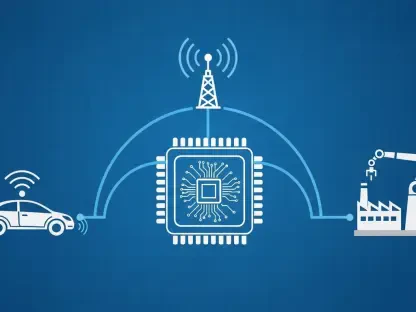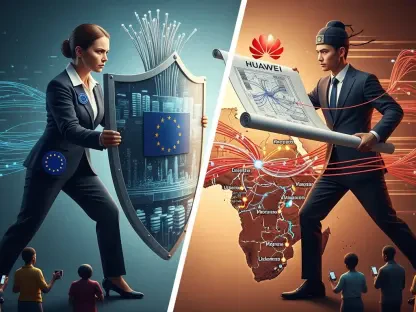The telecommunications industry is under immense pressure to address its environmental footprint, with global network operations consuming vast amounts of energy and contributing significantly to carbon emissions. As digital connectivity becomes the backbone of modern society, the sector faces a daunting challenge: how to balance the insatiable demand for data and innovation with the urgent need for sustainable practices. This review delves into the cutting-edge technologies and strategies shaping sustainability in telecom, examining their features, real-world performance, and potential to redefine industry standards.
Key Technologies Driving Sustainability
Hardware Longevity and Circular Economy Solutions
One of the standout approaches in telecom sustainability involves extending hardware lifecycles through circular economy principles. Initiatives like refurbished device programs and hardware repurposing are gaining traction as effective ways to minimize waste. By focusing on reusing and recycling components, companies are reducing the need for new production, thereby cutting down on resource consumption and environmental degradation.
A deeper look reveals how these solutions perform in practice. Programs that refurbish devices for secondary use not only curb e-waste but also offer cost savings for both providers and consumers. The scalability of such efforts is evident in large-scale projects, such as repurposing equipment from major events for other organizational needs, showcasing a model that can be adapted across the sector.
Beyond immediate benefits, these technologies foster a mindset shift in telecom operations. Circular practices encourage designing products with end-of-life recycling in mind, pushing manufacturers to prioritize durability and modularity. This systemic change, while still evolving, holds promise for long-term reductions in environmental impact.
Energy-Efficient Network Innovations
Another critical area of advancement lies in energy-efficient network technologies, which aim to optimize performance while slashing power consumption. Developments such as advanced network models and efficient codecs for next-generation systems are at the forefront of this transformation. These innovations are designed to handle increasing data loads without proportional increases in energy use.
Performance metrics for these technologies are impressive, with some network models achieving up to 50% energy savings in operational tests. Such efficiencies are vital as telecom infrastructure expands to meet global connectivity demands. The dual advantage of enhanced user experience and lower operational costs makes these solutions particularly appealing to industry stakeholders.
However, integrating these technologies into existing systems poses challenges. Upgrading infrastructure to support energy-efficient designs often requires significant investment and coordination. Despite this, the potential for widespread adoption remains high, as the long-term benefits of reduced energy bills and compliance with environmental standards become clearer.
Real-World Performance and Applications
The practical application of sustainable technologies in telecom offers valuable insights into their effectiveness. Long-term agreements for renewable energy sourcing, such as securing a portion of electricity from wind power, demonstrate how companies are transitioning to cleaner energy alternatives. These arrangements not only lower carbon footprints but also stabilize energy costs over time.
Regulatory support further amplifies the impact of these technologies. Proposals to combat software obsolescence ensure that devices remain functional for longer periods, reducing the frequency of replacements. Additionally, guidelines promoting restraint in high-energy digital consumption, like limiting high-definition streaming on small screens, contribute to overall energy conservation in the sector.
Unique case studies highlight the adaptability of sustainable practices. For instance, repurposing hardware from large-scale events for other purposes illustrates how temporary infrastructure can have a lasting positive impact. These examples serve as blueprints for other companies looking to implement similar strategies, proving that sustainability can align with operational goals.
Challenges in Implementation and Performance
Despite the promise of these technologies, several barriers hinder their widespread adoption. The high energy demands of emerging innovations, particularly power-intensive hardware for network operations, often counteract sustainability goals. This tension underscores the difficulty of aligning environmental objectives with the rapid pace of technological advancement.
Market dynamics also play a significant role in slowing progress. Surveys indicate that many telecom leaders are reevaluating sustainability timelines due to competing priorities, such as geopolitical concerns and customer-driven demand for cutting-edge services. This shift in focus can delay the integration of green technologies, even when their long-term benefits are acknowledged.
Efforts to overcome these hurdles are underway through partnerships and innovation. Collaborations between technology providers and energy firms are yielding new solutions to balance performance and efficiency. While these initiatives show potential, the complexity of managing multiple priorities remains a persistent obstacle to achieving comprehensive sustainability in telecom.
Final Thoughts and Next Steps
Reflecting on this evaluation, the technologies driving sustainability in telecom show remarkable potential to reshape industry practices, even as they grapple with significant challenges. Energy-efficient network innovations and circular economy solutions stand out for their ability to deliver measurable environmental benefits while maintaining operational performance. Their real-world applications provide concrete evidence of impact, from renewable energy agreements to hardware repurposing projects.
Looking ahead, the path forward demands a stronger emphasis on collaboration across the industry. Telecom companies, regulators, and technology developers must work together to prioritize scalable solutions that address both energy consumption and hardware waste. Investing in research for next-generation efficiencies, particularly in managing power-intensive advancements, emerges as a critical next step.
Moreover, aligning sustainability with business incentives proves essential for sustained progress. Crafting policies that reward green practices and integrating environmental goals into core strategies offer a viable way to maintain momentum. By focusing on these actionable measures, the telecom sector can solidify its role as a leader in global sustainability efforts, ensuring that connectivity and environmental stewardship go hand in hand.









